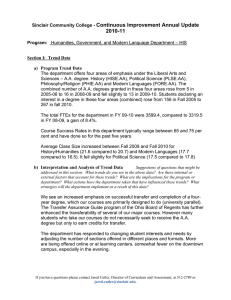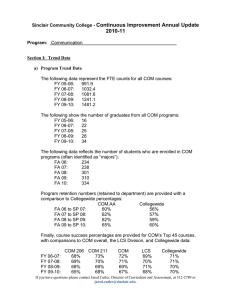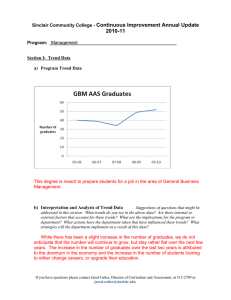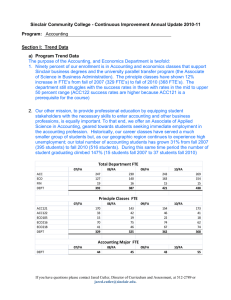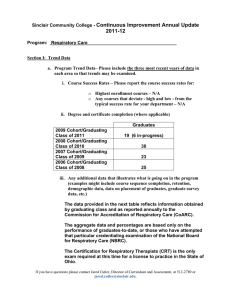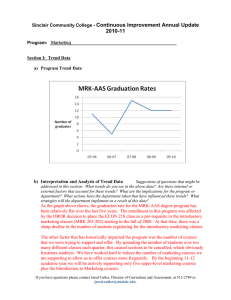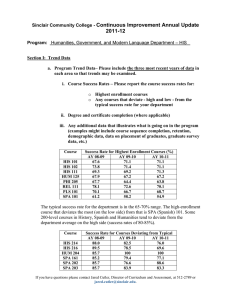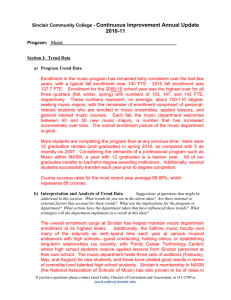Continuous Improvement Annual Update 2010-11
advertisement
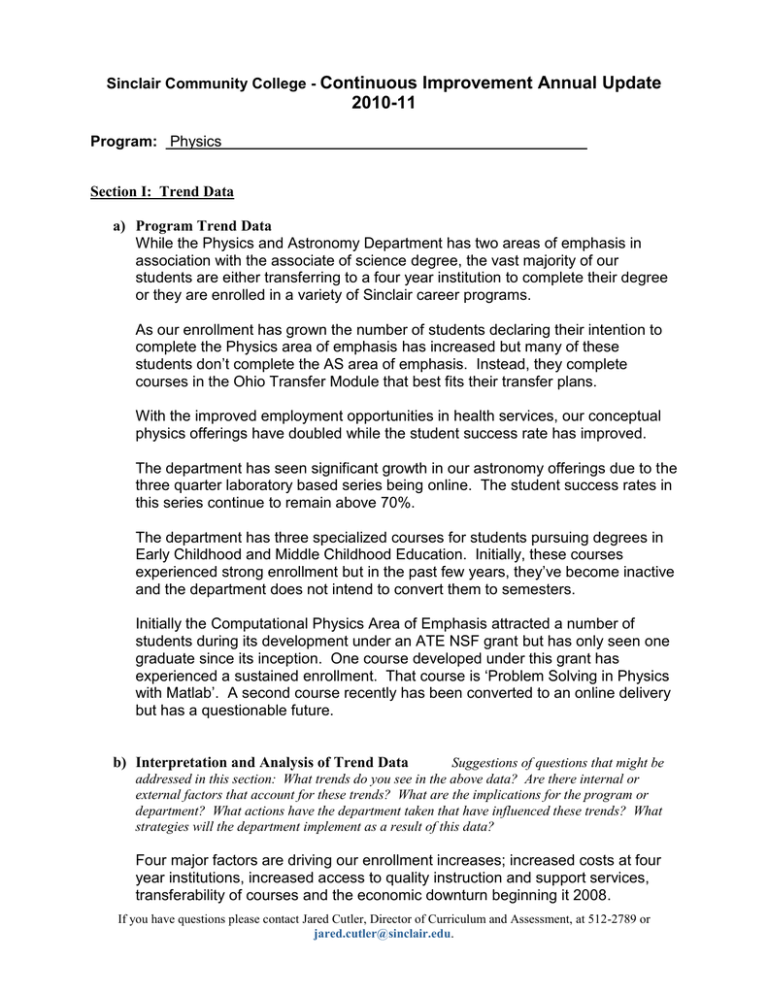
Sinclair Community College - Continuous Improvement Annual Update 2010-11 Program: Physics Section I: Trend Data a) Program Trend Data While the Physics and Astronomy Department has two areas of emphasis in association with the associate of science degree, the vast majority of our students are either transferring to a four year institution to complete their degree or they are enrolled in a variety of Sinclair career programs. As our enrollment has grown the number of students declaring their intention to complete the Physics area of emphasis has increased but many of these students don’t complete the AS area of emphasis. Instead, they complete courses in the Ohio Transfer Module that best fits their transfer plans. With the improved employment opportunities in health services, our conceptual physics offerings have doubled while the student success rate has improved. The department has seen significant growth in our astronomy offerings due to the three quarter laboratory based series being online. The student success rates in this series continue to remain above 70%. The department has three specialized courses for students pursuing degrees in Early Childhood and Middle Childhood Education. Initially, these courses experienced strong enrollment but in the past few years, they’ve become inactive and the department does not intend to convert them to semesters. Initially the Computational Physics Area of Emphasis attracted a number of students during its development under an ATE NSF grant but has only seen one graduate since its inception. One course developed under this grant has experienced a sustained enrollment. That course is ‘Problem Solving in Physics with Matlab’. A second course recently has been converted to an online delivery but has a questionable future. b) Interpretation and Analysis of Trend Data Suggestions of questions that might be addressed in this section: What trends do you see in the above data? Are there internal or external factors that account for these trends? What are the implications for the program or department? What actions have the department taken that have influenced these trends? What strategies will the department implement as a result of this data? Four major factors are driving our enrollment increases; increased costs at four year institutions, increased access to quality instruction and support services, transferability of courses and the economic downturn beginning it 2008. If you have questions please contact Jared Cutler, Director of Curriculum and Assessment, at 512-2789 or jared.cutler@sinclair.edu. As four year institutions have raised tuition rates an increasing number of students complete more of their education at Sinclair. To meet this demand our department has developed a very accommodating scheduling strategy that permits students to begin three quarter sequences every quarter including the summer. The department has improved the quality of the Physics Resource Laboratory (PRL) service and the quality of the learning environments in the classroom and labs. The PRL coordinator utilizing a effective balance of student and master tutors. This approach has significantly decreased student complaints about the PRL and the tutors. The department has increased the number of sections where the lecture and laboratory components of a course are integrated. In past years there were only a few sections. As these instructors improved their instructional techniques for this type of learning environment, students began to gravitate to these sections causing them to close first.. These early successes have inspired more faculty to move to this type of offering. Because of this change in the learning environment, student success rates have improved across all of our offerings. The astronomy courses continue to achieve 70% student success rates even though the majority of the students are enrolled in online sections. This is attributed to working on modules that cover small blocks of material. In each module students engage in discussions and other exercises which provide the student with feedback that assists them in mastering the outcomes. As mentioned earlier, our department predominately serves transfer students and students enrolled in career programs at Sinclair. Students don’t pursue the area of emphasis in physics for one of two reasons; 1) there are no employment opportunities with an AS degree and 2) receiving the AS prior to transferring is usually more costly than simply completing the OTM or a major portion of it. PRL support has improved through increased awareness of its usefulness. Better tutors Increased access through online delivery Laptop laboratories are integrated into courses Integrated lecture-lab increased and is much improved Section II: Progress Since the Most Recent Review a) What was the fiscal year of the most recent Program Review for this program? Our last annual review was in the 2004-05 academic year. If you have questions please contact Jared Cutler, Director of Curriculum and Assessment, at 512-2789 or jared.cutler@sinclair.edu. b) Briefly summarize the goals that were listed in Section IV part E of the most recent Program Review Self-Study (this section of the Self-Study asks “What are the department’s/program’s goals and rationale for expanding and improving student learning, including new courses, programs, delivery formats and locations”)? The department has taken great strides to expand the number of integrated lecture-lab offerings. With this change instructors have had to rework their curriculum to meet the challenges of this much improved learning environment and to implement effective formative assessment tools. Since our review, the department has developed an entire sequence of online astronomy with the labs. This effort pioneered the offering of a laboratory based science online at Sinclair and has set a very high bar for student success in online science education. Under the STEP NSF grant a course entitled, Scientific Thought and Method, SME110 was developed. This course was required in the ESUP program but this requirement will discontinue in the Fall of 2011. Most likely this will lead to the course being deactivated. c) Have these goals changed since your last Program Review Self-Study? If so, please describe the changes. Our continued focus is to improve the learning environments in our offerings and student success rates. d) What progress has been made toward meeting any of the goals listed above in the past year? More faculty are using the integrated lecture-lab model and with it, student success is improving across an increasing number of our offerings. e) What Recommendations for Action were made by the review team to the most recent Program Review? What progress has been made towards meeting these recommendations in the past year? The department has reviewed curriculum and has deactivated several courses. PHY133 has been deactivated and PHY295 will not be converted to semesters. Part time faculty are frequently updated in order to keep them current with newly developed curriculum materials and technological improvements. Section III: Assessment of Outcomes The Program Outcomes for this program are listed below. At least one-third of your program outcomes must be assessed as part of this Annual Update, and across the next three years all of these program outcomes must be assessed at least once. Physics Program Outcomes 1) Critical Thinking / Problem Solving In which courses are these program outcomes addressed? PHY100 PHY104 Which of these program outcomes were assessed during the last fiscal year? Assessment Methods Used Formative Assessments If you have questions please contact Jared Cutler, Director of Curriculum and Assessment, at 512-2789 or jared.cutler@sinclair.edu. PHY131-2 PHY141-3 PHY201-3 PHY210 PHY211 PHY212 PHY220 PHY245 AST101 AST111-3 Summative Assessments a) For the assessment methods listed in the table above, what were the results? What changes are planned as a result of the data? How will you determine whether those changes had an impact? In the conceptual courses, historically students have difficulty connecting concepts, theories, research methods and critical thinking skills. Sections of integrated lecture-lab provide a learning environment that has improved student proficiencies as measured by student success. Students in calculus based physics have been observed to have difficulty understanding dynamics and force without a proper understanding of motion variables (e.g. velocity and acceleration). This problem has been addressed through an increased use of intensive hands on activities in the integrated lab/lecture environment. This has been accomplished by utilizing portable laptop labs with computer interfaces for data collection. This approach has some students engaging in hands-on activities over 50% of the time. This has improved student retention and success. b) What other changes have been made in past years as a result of assessment of program outcomes? What evidence is there that these changes have had an impact? The department works more closely with part time faculty to assure they are improving their instruction. Curriculum materials and teaching successes are shared more frequently. The PRL has implemented a much better hiring process for tutors. This practice has reduced the number of student complaints about the PRL while the number of student visits has increased. c) Describe general education changes/improvements in your program/department during this past academic year (09-10). A long standing mathematics prerequisite for General Physics I has been enforced much more rigorously. This has created stronger student cohorts which complete the entire three quarter sequence with reduced attrition. If you have questions please contact Jared Cutler, Director of Curriculum and Assessment, at 512-2789 or jared.cutler@sinclair.edu. Section IV: Improvement Efforts for the Fiscal Year a) FY 09-10: What other improvement efforts did the department make in FY 09-10? How successful were these efforts? What further efforts need to be made? If your department didn’t make improvement efforts during the fiscal year, discuss the strengths and weaknesses of the department over the last year and how the department plans to address them in the coming year. The PRL is attempting to install a new card reader. With this card reader and the proper support software, the PRL coordinator can provide faculty information about how their students are utilizing the PRL. The department plans to extend the number of integrated lecture-lab sections and refine curriculum materials for them. b) FY 10-11: What improvement efforts does the department have planned for FY 10-11? How will you know whether you have been successful? In some instances, part time faculty have higher attrition rates the full time faculty. The department plans to share the lessons learned with part time faculty who are willing to improve and terminate the use of those who choose not to improve. Attrition rates will be monitored to determine our success in this endeavor. Questions regarding completion of the Annual Update? Please contact the Director of Curriculum and Assessment at 512-2789 to schedule a time to review the template and ask any questions. If you have questions please contact Jared Cutler, Director of Curriculum and Assessment, at 512-2789 or jared.cutler@sinclair.edu.
